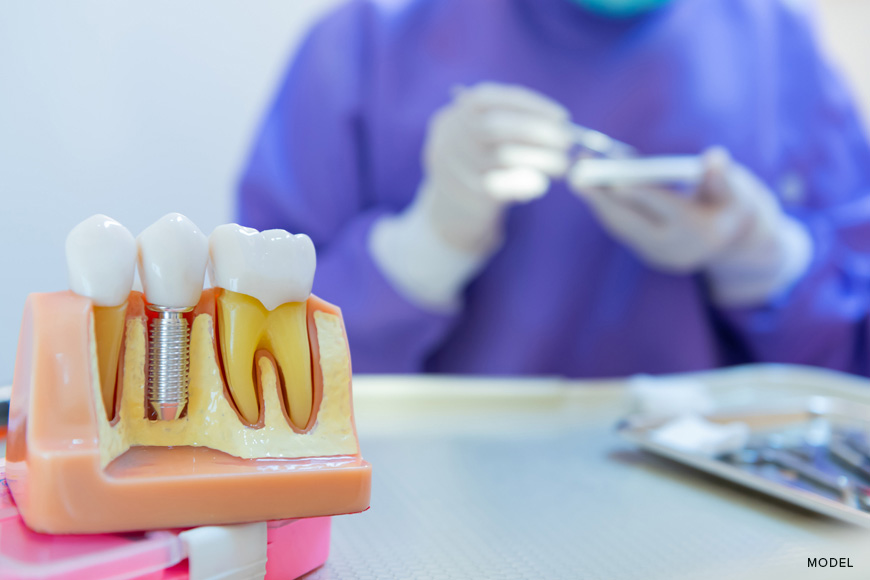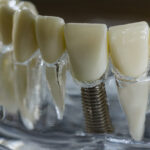Missing teeth not only affect confidence but also the overall physical health, as teeth are crucial in food consumption. This fact alone highlights the pressing need for a complete set of teeth.
According to the American College of Prosthodontics, 120 million people in the United States have at least one missing tooth. Another 36 million do not have any tooth at all in either one or both arches.
People with the problem of missing teeth often consider tooth replacement procedures. Among these are bridges, partial or full dentures, and dental implants as these procedures address the issue.
Dental Implants Planning
There is a crucial need for an excellent treatment plan as this affects the success rate of the actual procedure as well as the lifespan of the implants themselves. The planning involved in dental implants is a meticulous process that is best handled by an experienced dentist who has access to the latest technology.
-
Initial Consultation
Getting to know the patient and discussing the results they have in mind with them could be a good way to start the treatment plan. Having this kind of discussion is a good opportunity to inform the patient about their particular situation, answering any other concerns, and managing their expectations of the procedure.
It’s important to answer the question, “what kind of dental profile do you wish to project to people?” Dentists often share photos of past cases and digital models and animations of final prosthetics so that the patient may visualize and communicate their desired results better.
From here, dentists can provide their patients with all the possible options appropriate for their needs. Since the end results are being discussed, this is also a chance for informed consent — a process in which patients are briefed regarding the treatment and its benefits and risks. For the patient to make a fully informed decision, other tooth replacement procedures aside from dental implants should be discussed as well.
This is also the time when the patient can choose between fixed or removable prosthetics. If the prosthetic is fixed, the denture or teeth cannot be taken out of the mouth. This is because the non-removable denture, crown, or bridge is installed to the abutments with either implants or cement.
On the other hand, jaw implants can be used to support a removable prosthesis so that the two devices can be held securely together. The choice between the two becomes even more important when a full arch replacement is being planned.
-
Comprehensive Assessment of the Patient’s Health Status
The information gathered from the patient’s dental as well as overall medical history will dictate whether or not the patient is an ideal candidate for implants. The dentist will look into the patient’s current oral condition, specifically for any existing mobile or loose teeth, cavities, tooth decay, as well as dental restorations.
The assessment also involves looking for contraindications, which make anesthesia and the placement of dental implants inadvisable. Absolute contraindications that require medical clearances may include bleeding issues, heart and bone diseases, any active cancer, psychiatric illness, and strongly irradiated jaw bones.
There are also relative contraindications that will be evaluated according to the judgment of the dentist. This means that it will be up to the dental health professional to decide if the implant procedure can push through. They can only do so with extreme caution after a few preliminary treatments. Relative contraindications can include pregnancy, auto-immune diseases, angina pectoris, and diabetes.
Even the patient’s lifestyle habits such as tobacco or prohibited drug use and alcohol consumption can affect the eligibility for a dental implant procedure. Past procedures such as head and neck surgeries, radiation therapy, as well as other cancer treatments can also play a role. The dentist will also check the patient’s nutritional status and if there are diseases involving the salivary glands.
Should there be any existing illness, the patient may be advised to consult with and secure a medical clearance from their primary physician. The dentist will also have to first treat any concerning dental conditions before proceeding to the next step of the dental implant planning.
-
CBCT 3D Scan

Traditional X-rays are a thing of the past. Due to advancements in the field of dental health science, more and more dentists now rely on CBCT 3D machines. Also known as Cone Beam Computed Tomography, this piece of ultramodern equipment captures images of the mouth, as well as the entire neck and skull area, with great accuracy. It is therefore beneficial for dental implant placement planning.
A CBCT scan usually takes about 10 seconds, with very little emission of radiation during the process. The machine collects the data images, which will be transferred and stored in a dedicated computer.
After the digital data have been acquired and collected, the machine can now render from 100 to 600 images to reconstruct a model of the entire skull. The reconstruction process can take several minutes as the software takes time to process the collected images.
When used in dental implant planning, the dentist can show the virtual positions of multiple implants. This gives the patient a visual reference of the end results. This also allows the dentist to check the current status of the bone position, helping them to devise a much more appropriate plan. It can even help them decide if a bone graft will be needed along the way, or if the patient’s bone height can already support the prosthetics.
The CBCT scan is an integral part of dental implant planning because the data gathered can inform the surgical guide. The surgical guide allows the dentist to position the implants in their precise and pre-planned location. It also includes another crucial consideration, namely the depth of the implant.
Improper placement of the implant can negatively impact the future restorative procedures required to insert fixed-implant prosthetics.
-
Choosing the Implant and the Abutment
Implants and abutments are available in various shapes and sizes. Your dentist will choose them according to your dental anatomy. The implant and abutment design can play a huge role in the success of implant planning as this has an impact on the health of soft tissue around an implant.
The two options depend on the surface of an implant: which is either rough or polished. The main difference between them lies in whichever is better for your tissues or bones.
Polished surface implants are better at keeping the good health of the soft tissue compared to a rough surface. This is because bacteria are less likely to cling to a polished surface. On the other hand, rough surfaced implants are healthier for the bone as they are conducive to bone formation.
Generally, larger implants and abutments are selected for the back part of your arch due to the chewing functions of the said area. But too much width for any area can negatively affect the results of your procedure.
If the implant used is too wide, you are exposed to a higher risk of bone loss and soft tissue recession. The soft tissue can also be affected by the type of abutment of the implants. While there are other types of abutment that include stock and gold cast, custom abutments are considered as the best because these can ensure soft tissue health around the implant.
-
Choosing between one-way or two-stage procedure
For the final step of your dental implant planning, your dentist will decide which surgical technique will be employed in your procedure. One-stage procedure involves installing a healing abutment during the surgery.
This procedure is generally used if the bone quality is already good enough to ensure initial implant stability. The recovery period can take from 3-6 months, which is typically the span of time when the implant fuses to the bone. During this period, a provisional crown is placed on the implant and gives the patient an immediate appearance of a natural-looking tooth.
The main advantages of the one-stage procedure are its shorter surgery time and the immediate placement of the provisional tooth. This procedure is also ideal if the implant sites are in the front areas of the mouth, where aesthetics is a concern.
The two-stage dental implant procedure involves two surgeries, allowing for higher success to achieve the desired results. In its first stage, your dentist will place the implant into the jawbone and let the gum tissues cover it. The recovery period for this can take from 2-3 months.
Once healed, your dentist can now begin the second stage, where they will uncover the dental implant and attach the abutment to the fixture. The need for a two-stage procedure is to first address the low bone quality and later to ensure implant stability at placement. There may also be other health conditions that may determine if this approach is the only way to go.
Let’s Work Together Toward Your Complete Smile
When our patients visit Madison Dentistry, we assure them that we’ll provide personalized dental care. This approach is crucial in whatever procedure we do that can enhance the aesthetics and even your overall oral health.
It is significant that your veneers be done by an experienced dentist. However, choosing the right dental professional lies in the specific issue you wish to solve. Cosmetic dentists can solve cosmetic concerns, while you may visit an orthodontist for fixing your teeth alignment. If you have existing oral health concerns, then a general dentist is likely the best one to visit.
There is a meticulous process involved in the planning of dental implants, which can be best handled by experienced dental health professionals. Call us today at 973-822-8003 or send us a message on our contact page if you are interested in having a dental implant procedure performed by the expert team of Madison Dentistry. For our next blog, we will be sharing with you aftercare tips following a dental implant treatment.




